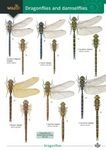![Die Eiszeitlibellen der Alten Welt: Pleistozäne Biogeographie Paläarktischer Libellen [Ice-Age Odonata of the Old World. The Pleistocene Biogeography of Palearctic Dragonflies] Die Eiszeitlibellen der Alten Welt: Pleistozäne Biogeographie Paläarktischer Libellen [Ice-Age Odonata of the Old World. The Pleistocene Biogeography of Palearctic Dragonflies]]()
Click to have a closer look
About this book
Customer reviews
Related titles
About this book
Language: German with bilingual summary in English and German
In the present volume, the author discusses the Pleistocene distribution dynamics of boreal dragonfly species in the Palearctic. For this purpose, palaeontological, autecological and propagation dynamics findings, as well as results of Pleistocene research are combined into a synthesis to models of Pleistocene areal formation processes. As far as possible with these methods, speciation processes of dragonflies are presented. The author shows that climate change, combined with a change of whole landscapes, has probably been the trigger of evolutionary processes in some dragonfly taxa.
Amongst the listed species, two groups are distinguished: species that show strong adaptations to cold environmental conditions and species that tolerate a broad temperature range. Within these two groups the author was able to make further distinctions:
- circumsubarctic and circumtundral species, "permafrost soil species"
- Recent boreomontane species
- Stenotope species with boreal distribution
- Recent transpalaearctic-boreomontane species
- Eastern Palaearctic species, Siberian species found in disjointed areas
- Late glacial glacier margin species
- Western Palearctic species
- Species with western to central Palaearctic distribution
- Species with transpalaearctic distribution and without subspecies
- Western and Eastern Palearctic sisters or subspecies
- Flowing water species
Distribution areas and areal histories for each of these groups are described in detail for typical species and characterized by recent, and in some cases hypothetical, cold-period disitrbution maps. The faunas are presented for different Palaearctic regions that still contain a more or less large proportion of cold-seasonal fauna elements.
This treatise is not only aimed at entomologists and odonatologists. This volume is also relevant for scientists who are particularly interested in recent palaeogeography, zoogeography or climate-related evolutionary processes. The results presented here are also eminently important for species protection, as we are currently experiencing a period of dynamic climate change.
Summary in German:
Im vorliegenden Band behandelt der Autor die pleistozäne Verbreitungsdynamik borealer Libellenarten in der Paläarktis. Hierzu werden paläontologische, autökologische und ausbreitungsdynamische Erkenntnisse sowie Ergebnisse der Pleistozänforschung in einer Synthese zu Modellen pleistozäner Arealbildungsprozesse vereinigt. Soweit mit diesen Methoden möglich, werden Artbildungsprozesse der Libellen dargestellt. Der Autor zeigt, dass der Klimawechsel, verbunden mit der Veränderung ganzer Landschaften, wohl ein Auslöser evolutionärer Prozesse in einigen Libellentaxa gewesen ist.
Bei den aufgeführten Artbeispielen werden zwei Gruppen unterschieden: Arten, die starke Anpassungen an kalte Umweltbedingungen zeigen sowie Arten, die ein breites Temperaturspektrum tolerieren. Innerhalb dieser beiden Gruppen konnte er weitere Unterscheidungen vornehmen:
- Zirkumsubarktische und zirkumtundrale Arten „Permafrostbodenarten“
- Rezent boreomontan verbreitete Arten
- Stenotope Arten mit borealer Verbreitung
- Rezent transpaläarktisch-boreomontan verbreitete Arten
- Ostpaläarktische Kaltzeitwanderer, disjunkte Areale sibirischer Arten
- Spätglaziale Gletscherrandwanderer
- Westpaläarktische Arten
- Arten mit west- bis zentralpaläarktischer Verbreitung
- Arten mit transpaläarktischer Verbreitung und ohne Unterarten
- West- und ostpaläarktische Schwesternarten oder Unterarten
- Fließwasserarten
Verbreitungsgebiete und Arealgeschichten für jede dieser Gruppen werden für typische Arten ausführlich beschrieben und anhand von rezenten und in einigen Fällen hypothetischen kaltzeitlichen Arealkarten charakterisiert. Für verschiedene Regionen der Paläarktis werden Faunen vorgestellt, die noch einen mehr oder minder großen Anteil von kaltzeitlichen Faunenelementen beinhalten.
Die Abhandlung richtet sich nicht nur an Entomologen und Odonatologen. Auch für Wissenschaftler, deren besonderes Interesse der jüngeren Paläogeografie, der Zoogeografie oder klimatisch bedingter evolutiver Prozesse gilt, ist dieser Band relevant. Die hier vorgestellten Ergebnisse sind auch für den Artenschutz von eminenter Bedeutung, befinden wir uns doch gerade in einer Zeit dynamischer Klimaveränderung.
Customer Reviews






![Die Eiszeitlibellen der Alten Welt: Pleistozäne Biogeographie Paläarktischer Libellen [Ice-Age Odonata of the Old World. The Pleistocene Biogeography of Palearctic Dragonflies] Die Eiszeitlibellen der Alten Welt: Pleistozäne Biogeographie Paläarktischer Libellen [Ice-Age Odonata of the Old World. The Pleistocene Biogeography of Palearctic Dragonflies]](http://mediacdn.nhbs.com/jackets/jackets_resizer_xlarge/24/245896.jpg?height=620)
![Die Eiszeitlibellen der Alten Welt: Pleistozäne Biogeographie Paläarktischer Libellen [Ice-Age Odonata of the Old World. The Pleistocene Biogeography of Palearctic Dragonflies]](http://mediacdn.nhbs.com/jackets/jackets_resizer/24/245896.jpg)









![Die Eiszeitlibellen der Alten Welt: Pleistozäne Biogeographie Paläarktischer Libellen [Ice-Age Odonata of the Old World. The Pleistocene Biogeography of Palearctic Dragonflies]](http://mediacdn.nhbs.com/jackets/jackets_resizer_medium/24/245896.jpg?height=150&width=111)





















